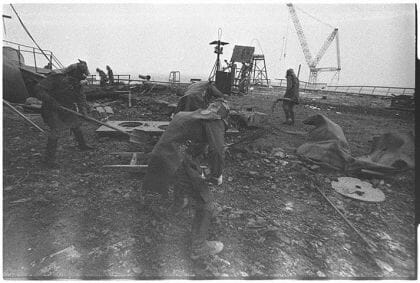A press photographer, who took pictures of the Chernobyl nuclear disaster and Pripyat during early days after plant explosion, Igor Kostin captured haunting images showing the true scale of the Chernobyl nuclear disaster. The black and white shots revealed the truth behind the tragedy Soviets were trying to cover up.
Within hours of the explosion on April 26, 1986, comrade Kostin knew he witnessed an event that would be engraved in history books. He was right. Reactor #4 at the V. I. Lenin Nuclear Power Plant near Chernobyl exploded, releasing 400 times more radioactive matter than the bombing of Hiroshima. He was a skilled photographer and dedicated to his work. His professionalism and unbreakable will have made him immortal. At the very least, his photography will remain for centuries to come. He died at 78 years old.
By the mid 1970s, Kostin had lost most of his interest in his occupation, engineering. He was frustrated with work. He enjoyed photography, specifically portraitures, winning a gold medal for a portrait of his wife, Alla, in Kyiv’s annual photo exhibition. He attempted for apply for a placing at NOVOSTI PRESS Agency (APN) in Moscow. He was rejected and returned to Kyiv. There he was employed as war reporter for APN Ukraine. Kostin covered some of the most graphic third-world wars that the Soviet Union was involved in, such as the Vietnam War and the Soviet intervention in Afghanistan.
In the late evening of April 26, 1986, a helicopter pilot, whom he worked closely with in his journalistic activities, alerted him that there had been a fire at the nuclear power plant in Chernobyl. The fire had been extinguished by the time they arrived at Chernobyl via helicopter; nonetheless, he witnessed a war-like scramble of military vehicles and power plant personnel at the scene. He also experienced an odd feeling, high temperatures, and toxic smog, which was unusual for an accident scene. His first images were taken from a helicopter 25 meters above the plant. His camera began to exhibit symptoms of radioactive degradation after only 20 shots, so the helicopter returned to Kyiv after the camera failure.

Kostin managed to develop the films, only to realize that all but one was unsalvageable—most of the negatives were affected by the high level of radiation, which caused the photographs to appear entirely black like a film exposed to light pre-maturely. One shot remains of the disaster. Kostin′s only photograph of the nuclear power plant was sent to Novosti in Moscow, but he did not receive a permit to publish it until May 5, 1986. His visit to Chernobyl was not sanctioned by the authorities. Pravda published limited information about the accident on April 29, 1986, but they did not publish Kostin’s photographs.
The accident was shown as a major catastrophe by the global news media, even though the Ukrainian and Soviet authorities tried to suppress any news regarding the accident. Kostin later received permits as one of the five accredited Soviet journalists to cover the accident site and the Exclusion Zone. On May 5, 1986, he ventured into the rubbles of the Chernobyl nuclear plant site, Reactor 4, and the liquidators.
It was then that he covered the mass exodus of the inhabitants of Pripyat and the 30 km zone surrounding the nuclear power plant. Hundreds had died in the accident, mostly workers at the nuclear power plant, who suffered from thyroid cancer after receiving more five times the allowable dose of radiation.
In the following months and years, Kostin repeatedly returned to the contamination zone to document the cleanup efforts, calling them “stories of brave men, liquidators”. For the next twenty years, he persistently investigated the explosion’s effects on mankind and the environment. He captured more than five thousand photographs of the Chernobyl disaster and its aftermath. His collection tells the incredible personal stories of those impacted by the disaster, including the liquidators, soldiers, scientists and residents throughout Belarus, Ukraine, Russia who have been socially, politically, and medically impacted by the catastrophe. His images of a deformed boy even led to adoption of the term “Chernobyl child” in UK.
Kostin discovered this deformed child in a special school for abandoned children in Belarus. The photo was published in the local Belarus press and the boy nicknamed ‘the Chernobyl Child’, 1988

Liquidators clean the roof of reactor 3. Liquidators could not stay any longer than 40 seconds any one time, 1986

The former director of the Chernobyl site, Viktor Bryukhanov, with his wife in their apartment on returning home after serving a ten-year prison sentence for his involvement in the catastrophe, 1997

More his pictures on our PINTEREST
Thank you for your images and sacrifice, comrade Kostin. Rest in peace



 ChernobylX
ChernobylX
 ChernobylX
ChernobylX